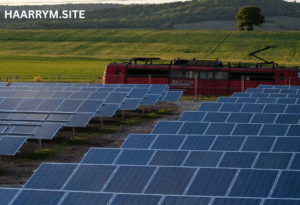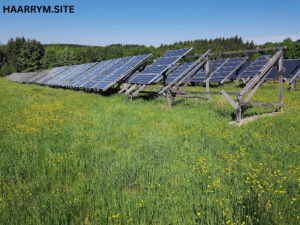Solar power has grown to be among the most easily available and efficient ways to lower reliance on fossil fuels as the globe moves towards greener energy sources. Although conventional solar systems have long depended on string inverters, new technology is transforming the way solar energy is used: solar micro inverters.
The definition, operation, benefits over conventional systems, popular use cases, and what to search for when purchasing a solar micro inverter will be covered on this page. This thorough tutorial will lead you through everything you need to know about solar micro inverters regardless of your level of knowledge about solar technology—that of a homeowner, installer, or simply inquisitive about solar technologies.
What is a Solar Micro Inverter?
Designed for use in homes or transmitted back to the grid, a solar micro inverter is a small electrical gadget that turns the direct current (DC) power generated by one solar panel into alternating current (AC). Micro inverters run on per-panel basis unlike conventional inverters, which are centralised and convert electricity from many panels at once.
Usually positioned either immediately beneath or next to its matching solar panel is each micro inverter. More effective energy conversion, more system flexibility, and more monitoring capacity are made possible by this distributed arrangement.
How Does a Solar Micro Inverter Work?
The main role of a micro inverter is to convert DC to AC efficiently. Here’s a step-by-step breakdown of how the process works:
-
Solar Energy Capture: Each solar panel captures sunlight and converts it into DC electricity.
-
Conversion at the Panel Level: The micro inverter attached to the panel converts this DC into AC.
-
AC Power to Your Home or Grid: The AC electricity is then sent to your home’s electrical panel or fed into the utility grid.
Because the conversion happens at the panel level, performance issues with one panel (e.g., shading, dirt) do not affect the output of the entire system — a significant improvement over traditional systems.
Benefits of Solar Micro Inverters
1. Increased Energy Production
One of the biggest advantages of micro inverters is maximized energy output. Since each panel operates independently, shading or malfunction of one panel doesn’t bring down the entire array’s performance. This allows for optimal energy harvesting across the entire solar array.
2. Improved Monitoring
Micro inverters allow for individual panel-level monitoring. This means you can track the performance of each panel in real time using a mobile app or web dashboard. If a panel underperforms, it’s easier to detect and address the issue quickly.
3. Enhanced Safety
Unlike string inverters, which carry high-voltage DC from the roof to the inverter, micro inverters convert electricity to AC right at the panel. This reduces the risk of electrical fires and improves overall system safety — a major consideration for residential and commercial properties.
4. Scalability
Micro inverter systems are highly scalable. You can start with a small number of panels and expand your system later without needing a new inverter. Each new panel simply gets its own micro inverter.
5. Longer Warranties
Micro inverters often come with longer warranties — typically around 20–25 years — matching the lifespan of solar panels. This reduces long-term maintenance costs and provides peace of mind.
6. Ideal for Complex Roofs
Homes with multiple roof angles, orientations, or partial shading benefit greatly from micro inverters. Since each panel functions independently, you can install panels in different directions and still get great performance.
Solar Micro Inverter vs String Inverter
| Feature | Solar Micro Inverter | String Inverter |
|---|---|---|
| Conversion Level | Per panel | One central location |
| Energy Yield | Higher (due to independence) | Lower (dependent on weakest panel) |
| Monitoring | Panel-level | System-level |
| Scalability | High | Moderate |
| Cost | Higher upfront cost | Lower upfront cost |
| Maintenance | Easier to diagnose and repair | Harder to isolate issues |
| Suitability | Ideal for complex roofs | Best for uniform sun exposure |
While string inverters are still commonly used due to their lower initial cost, the long-term benefits and increased energy yield of micro inverters often justify the investment — especially for residential systems or locations with less-than-ideal conditions.
When to Use Solar Micro Inverters
Micro inverters are best suited for the following scenarios:
-
Residential solar systems, especially on homes with varying roof angles
-
Small commercial installations looking for modular and scalable systems
-
Areas with frequent shading from trees, buildings, or chimneys
-
Installations that require detailed monitoring and reporting
-
Systems that need to be expanded over time
For utility-scale solar farms, string inverters or central inverters may still be more cost-effective due to scale. But for many homeowners and small businesses, micro inverters offer unbeatable flexibility and performance.
Top Solar Micro Inverter Brands
Several companies manufacture high-quality micro inverters. Here are some of the top players in the market:
1. Enphase Energy
Arguably the most well-known name in micro inverter technology, Enphase offers reliable, smart inverters with excellent monitoring systems. Their IQ Series micro inverters are highly efficient and widely used across residential installations.
2. APsystems
APsystems provides both micro inverters and advanced energy management solutions. Their dual-module micro inverters are cost-effective and suitable for larger residential or small commercial setups.
3. Hoymiles
Hoymiles specializes in cost-effective micro inverters that maintain quality performance. Their modular design is great for scalable systems and they have a growing presence in the global market.
4. Chilicon Power
This California-based company offers intelligent micro inverter solutions with robust data analytics features. Chilicon micro inverters are known for being easy to install and integrate.
What to Look for When Buying a Solar Micro Inverter
When shopping for a solar micro inverter, consider the following factors:
1. Compatibility
Ensure the inverter is compatible with your solar panels in terms of voltage, power output, and design.
2. Efficiency
Look for high CEC (California Energy Commission) efficiency ratings, ideally above 95%.
3. Warranty
Choose products that come with 20–25 year warranties to match the lifespan of your panels.
4. Monitoring Features
Inverters with app-based monitoring offer convenience and better system management. Ensure the inverter supports remote diagnostics.
5. Certifications
Check for relevant certifications such as UL1741, IEEE 1547, or CEC-approved lists depending on your region.
6. Expandability
If you plan to scale your system in the future, make sure the micro inverter allows for easy system expansion.
Installation Considerations
Though micro inverters are more plug-and-play compared to string inverters, proper installation is key to safety and performance. Always:
-
Use a certified installer or electrician.
-
Ensure weatherproofing for rooftop installations.
-
Maintain good airflow around the inverter for cooling.
-
Avoid mixing micro inverters and string inverters unless designed for hybrid use.
Some systems may also integrate battery storage or energy management software — make sure your inverter is compatible with these features if needed.
Cost of Solar Micro Inverters
The initial cost of a solar micro inverter system is typically higher than a string inverter setup. You can expect to pay around $150–$300 per inverter, depending on brand and model.
However, the long-term benefits often outweigh the upfront cost:
-
Better energy harvest = Lower electricity bills
-
Individual monitoring = Easier maintenance
-
Long warranties = Fewer replacements over time
When viewed as a 25-year investment, micro inverters can provide superior ROI — especially in challenging installation environments.
Future of Micro Inverter Technology
As the solar industry continues to evolve, micro inverter technology is also advancing. The future promises:
-
Higher power ratings to match newer, high-efficiency panels
-
Smarter systems with AI-based energy optimization
-
Integration with home automation and energy storage
-
Faster installations with snap-on, plug-and-play systems
The trend toward decentralized energy systems and smart homes aligns perfectly with the capabilities of micro inverters.

Conclusion
In the realm of renewable energy, solar micro inverters have become a revolutionary tool. For a variety of solar projects, they give a scalable and effective answer by including panel-level optimisation, enhanced safety, and sophisticated monitoring.
For many households and small companies, modular architecture, long-term performance advantages, and peace of mind usually make micro inverters the better option even if they may cost more initially than conventional string inverters.
Considering solar micro inverters might be one of the finest choices for energy efficiency and future-proofing your investment whether your plans call for solar or upgraded an existing system.
Frequently Asked Questions (FAQs)
Q1: Are micro inverters worth it?
Yes, especially for homes with shading issues, complex roof designs, or those wanting panel-level monitoring and scalability.
Q2: Can I mix micro inverters with string inverters?
It’s technically possible in hybrid systems, but generally not recommended unless explicitly designed that way.
Q3: How long do micro inverters last?
Most quality micro inverters last 20–25 years, matching the lifespan of most solar panels.
Q4: Do micro inverters work during a blackout?
No, unless connected to a battery backup system, micro inverters shut off during grid outages for safety.
Q5: How many micro inverters do I need?
Typically, one per solar panel, unless using dual or quad micro inverters that support multiple panels.
